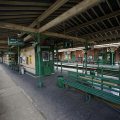
I’ll have to admit that it’s not the most picturesque village I’ve ever visited – in fact the signal box was the highlight for me – but here’s some photos from a recent visit to Cuxton.
The train from King’s Cross takes your past the striking Rochester Castle. You need to change to Strood and then travel one stop to Cuxton railway station.
It looks a bit tatty these days, but Cuxton Signal Box is amazingly still open and enjoys Grade II listed protection.
Historic England say:
Cuxton Signal Box, a South Eastern Railway Signal Box, on the Maidstone and Strood Railway (now known as the Medway Valley Line) and probably constructed in the late 1887-9, is designated at Grade II for the following principal reasons:
* Intactness: exterior unaltered except for a small later porch extension;
* Survival of operating equipment: contains a South Eastern Railway 7” Brady Lever Frame, possibly of 1892 and some train control instruments including the bell for the up line, a commutator and a track indicator;
* Group value: it is adjacent to a Gothic-style 1856 railway station.
Cuxton station building.
The footbridge has seen better days.
The only bit of graffiti in the village, and it’s rubbish.
The 80s styled delights of Cuxton Auto Services. The facility enjoys a 4.7 rating on Google.
Sign displaying the reason I was in Cuxton.
Peckham would go on to beat the home side 3-2 in a thrilling encounter. See photos and a match report here.
I guess the pump on the right isn’t working. Or it’s just hiding.
The hairdressing hub of Cuxton.
Cuxton’s football ground is nestled in the Kent countryside,
The game had a modest attendance.
Inside Cuxton’s pleasant bar and clubhouse.
Distant road and railway viaducts.
About Cuxton
Lying on the left bank of the River Medway in the North Downs, archaeological evidence suggest the first human occupation in the area was around 200,000 years ago.
Wikipedia adds:
The remains of a Roman villa were found under the church yard. The Saxons occupied the town and it became known as Cuckelstane. The church and parish was given by Æthelwulf, King of the West Saxons to the Cathedral church of St. Andrew, Rochester.
The church contains much Norman architecture, and is unusual as it lies on a southeast–northwest axis. This gave rise to the rhyme, He that would see a church miswent / Let him go to Cucklestane in Kent.
In Tudor times the principal house in the town was Whorne’s Place, erected on the river by Sir William Whorne, Lord Mayor of London in 1487. This was later owned by the Leveson family and most notably Sir John Leveson who was Lord Deputy Lieutenant of Kent.
This was taken over by the Mashams, strong royalists who moved on to the Mote in Maidstone. The mansion was demolished in 1782 and only an outlying granary, now a house still bearing the name Whorne’s Place, survives in 2011.
The only other manor in Tudor Cuxton was that of Beresse or Beresh, now known as Bush. It doesn’t survive.
In 1610, William Laud was rector of Cuxton; he later became Archbishop of Canterbury under Charles I and was executed by the puritans in 1645 because of his strong royalist loyalties.

